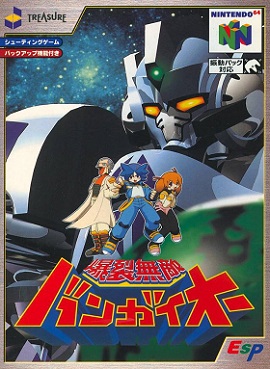
Bangai-O is a multidirectional shooter developed by Treasure and released in 1999 on the Nintendo 64 in Japan. It was ported to the Dreamcast worldwide shortly after with some gameplay changes and updated graphics and audio. The game places the player in control of a weaponized mech that can hover across large stages and fire at enemies all around them. The player must reach the end of each stage and defeat the boss, while avoiding hazards scattered across the map such as enemy mechs and gun turrets.
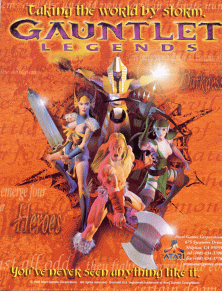
Gauntlet Legends is an arcade game released in 1998 by Atari Games and Midway Games. It is a fantasy themed hack and slash styled dungeon crawl game, a sequel to 1985's popular Gauntlet and 1986's Gauntlet II and marks the final game in the series to be produced by Atari Games. Its unusual features for an arcade game included passwords and characters that could be saved, enabling players to play over the course of a long period.
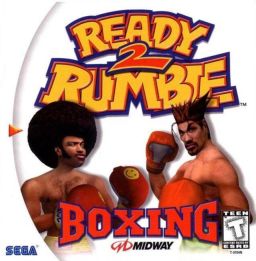
Ready 2 Rumble Boxing is a boxing video game developed by Midway Studios San Diego, and published by Midway in September 1999 for the Dreamcast. Ports for Nintendo 64 and PlayStation were developed by Point of View and released in November 1999 alongside a separate version for Game Boy Color by Crawfish Interactive. The success of the Dreamcast version led to it becoming one of the few Sega All Stars titles.
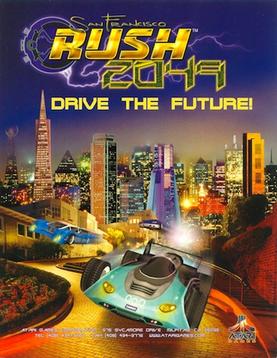
San Francisco Rush 2049 is a racing video game developed and manufactured by Atari Games for arcades. It was ported to the Nintendo 64, Game Boy Color, and Dreamcast by Midway Games West. The arcade machine was released in 1999; home versions followed in 2000 on September 7 for North America and November 17 for Europe. It is the third game in the Rush series and the sequel to San Francisco Rush: Extreme Racing and Rush 2: Extreme Racing USA. It is the last game in the Rush series to be set in the city of San Francisco and the last released on a Nintendo console. It also serves as the final game for the Atari Games label, which was retired shortly after the arcade release. The Dreamcast version was later re-released as part of Midway Arcade Treasures 3 for the PlayStation 2, Xbox, and GameCube and later for Microsoft Windows as part of Midway Arcade Treasures Deluxe Edition.

Star Wars Episode I: Racer is a 1999 racing video game based on the podracing sequence in the film Star Wars: Episode I – The Phantom Menace. The game features all of the racers and race course on Tatooine from The Phantom Menace. It adds several new courses, on Tatooine and various planets. It has several single player modes, including a tournament mode. The format of multiplayer mode varies by platform. Jake Lloyd and Lewis MacLeod, who portrayed Anakin Skywalker and Sebulba in The Phantom Menace, reprise their film roles in the game.

NBA Showtime is a basketball arcade game released by Midway in 1999, featuring teams and players from the National Basketball Association (NBA). The game is modeled after the NBA presentations on NBC and takes its name from NBC's NBA pregame show. It is the successor to Midway's previous basketball titles NBA Hangtime and NBA Jam and is the first in the series to have fully 3-D polygonal graphics, featuring real uniforms for all teams. Showtime was also featured in a dual game cabinet along with NFL Blitz 2000 that Midway dubbed the "SportStation." Midway followed up the game with the console exclusive NBA Hoopz.
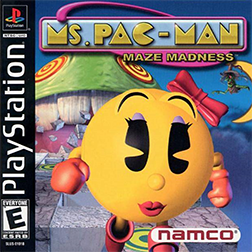
Ms. Pac-Man Maze Madness is a maze chase video game developed and published by Namco for the PlayStation in 2000. It was later released for the Nintendo 64, Dreamcast, and Game Boy Advance. A remake of Ms. Pac-Man (1982), players control the titular character in her quest to stop a witch named Mesmerelda from stealing the Gems of Virtue. The game was well-received upon release, with critics applauding its simplicity and faithfulness to the arcade original. A sequel was in development around 2006, but was cancelled for unknown reasons.
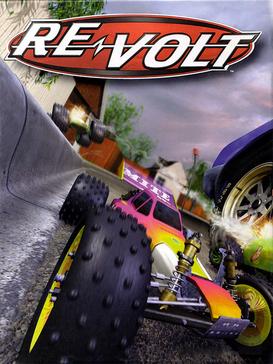
Re-Volt is a racing video game designed by Paul Phippen and Simon Harrison. It was developed by Acclaim Studios London and published by Acclaim Entertainment for Microsoft Windows, Nintendo 64, PlayStation and Dreamcast.
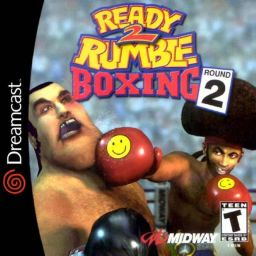
Ready 2 Rumble Boxing: Round 2 is a boxing game for the Dreamcast, Nintendo 64, PlayStation, PlayStation 2, and Game Boy Advance. It is the sequel to Ready 2 Rumble Boxing.
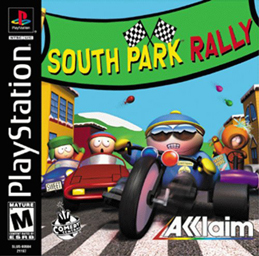
South Park Rally is a kart-style racing video game released in early 2000 based on the American animated sitcom South Park published by Acclaim Entertainment and released for the PlayStation, Microsoft Windows, Nintendo 64, and Dreamcast. Gameplay follows the player in a competitive racing championship set in the fictional town of South Park. Players are given the options for multiplayer, arcade, or championship modes, but only the championship unlocks extra features. Competition begins in South Park's 1st Rally, a circuit race around four checkpoints in the downtown area of South Park. Races get gradually more diverse, with more locations, racers, and elements added as the game progresses.

F-1 World Grand Prix, developed by Paradigm Entertainment, is a Formula One racing game/sim first released in 1998 for the Nintendo 64 game console and to later platforms including the Sega Dreamcast, Microsoft Windows, Sony PlayStation, and Game Boy Color. The Nintendo 64 version is based on the 1997 Formula One season, featuring each of the 17 circuits from the season and all 22 drivers, with the exceptions of Jacques Villeneuve and the MasterCard Lola team.

International Track & Field 2000 is a track and field game for PlayStation in 1999 and Nintendo 64 in 2000. It was released in Europe under the names International Track & Field: Summer Games on the Nintendo 64 and Game Boy Color, International Track & Field 2 on the PlayStation and International Track & Field on the PlayStation 2 and in Japan as Ganbare! Nippon! Olympics 2000, where it was licensed by the Japanese Olympic Committee. Versions were also released for the Sega Dreamcast, PlayStation 2, and Game Boy Color as ESPN International Track & Field in North America. Maurice Greene, a former men's WR holder in the 100M dash, is the cover athlete.
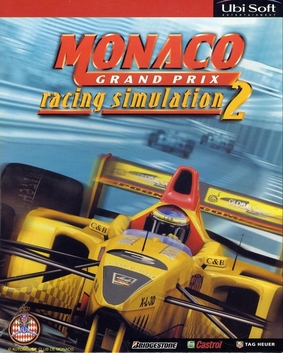
Monaco Grand Prix: Racing Simulation 2, also known as just Monaco Grand Prix or Racing Simulation: Monaco Grand Prix, is a Formula One racing game developed and published by Ubisoft for the Windows, Nintendo 64, PlayStation, and Dreamcast. It was released in 1998–1999. A sequel, Racing Simulation 3, was released in 2002.
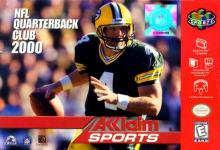
NFL Quarterback Club 2000 is a sports video game developed by Acclaim Studios Austin and published by Acclaim Entertainment for Nintendo 64 and Dreamcast in 1999.

Toy Story 2: Buzz Lightyear to the Rescue! is a 1999 platform game developed by Traveller's Tales and published by Activision and Disney Interactive. Based on Disney/Pixar's 1999 computer animated film Toy Story 2, it was released for the Nintendo 64, PlayStation, Microsoft Windows, and Macintosh in late 1999, while a Dreamcast version followed in 2000. The computer versions were released under the title Disney/Pixar's Action Game, Toy Story 2. A different version, a side-scrolling platform game titled Toy Story 2, was also released for the Game Boy Color in 1999.

NFL Blitz 2000 is a video game released in the arcades in 1999 and then ported to the PlayStation, Nintendo 64, Dreamcast, Windows, and Game Boy Color. It is the third game in the NFL Blitz series.

Jeremy McGrath Supercross 2000 is a motocross racing video game developed by Acclaim Studios Salt Lake City and published by Acclaim Entertainment under their Acclaim Sports label for Nintendo 64, Game Boy Color, PlayStation and Dreamcast. It features eight stadium tracks, eight outdoor tracks, and an option for players to create their own custom tracks. In addition to having a racing game mode, players could perform dirt bike tricks in a stunt mode.
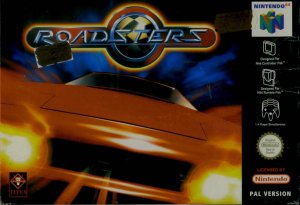
Roadsters is a racing game released by Titus Software for Nintendo 64 in 1999, and for PlayStation, Dreamcast and Game Boy Color in 2000. It is a car racing game that features both licensed cars from manufacturers and unlicensed cars from imaginary manufacturers that are based on and bear great resemblance to their equivalent, real car models. The game also includes a multi-player mode supports up to 2 human players that can compete in any of the available circuits with 4 more CPU controlled racers. A PlayStation 2 version was originally planned to release on April 11, 2001.

Cruis'n is a series of racing video games originally developed by Eugene Jarvis for Midway Games and published by Midway and Nintendo. The series distinguishes itself from other racing games with its over-the-top presentation and fast-paced gameplay, featuring a wide variety of vehicles and tracks based on a number of real world locations. The series debuted in North American and European arcades in 1994 with the release of Cruis'n USA, which, along with Killer Instinct, was advertised as running on Nintendo's Ultra 64 hardware. Two sequels followed, Cruis'n World and Cruis'n Exotica, which featured new vehicles and tracks. All three games were released for the Nintendo 64 as well, with Exotica also being released for the handheld Game Boy Color. The next game in the series, Cruis'n Velocity deviated from the traditional arcade gameplay of the series and was released for the Game Boy Advance.

NFL Blitz 2001 is a video game developed and published by Midway for the Dreamcast, PlayStation, Nintendo 64 and Game Boy Color in 2000.





















